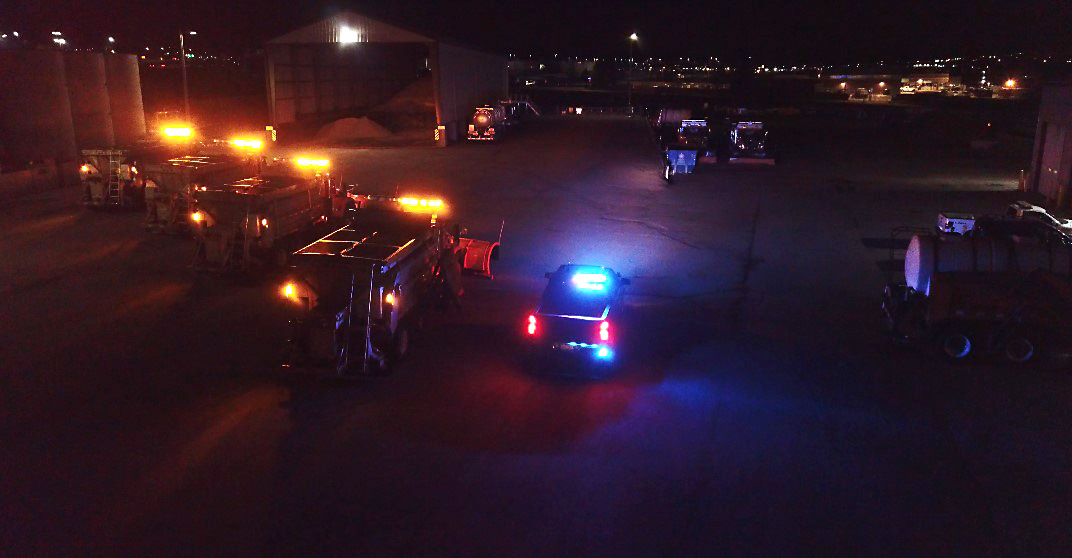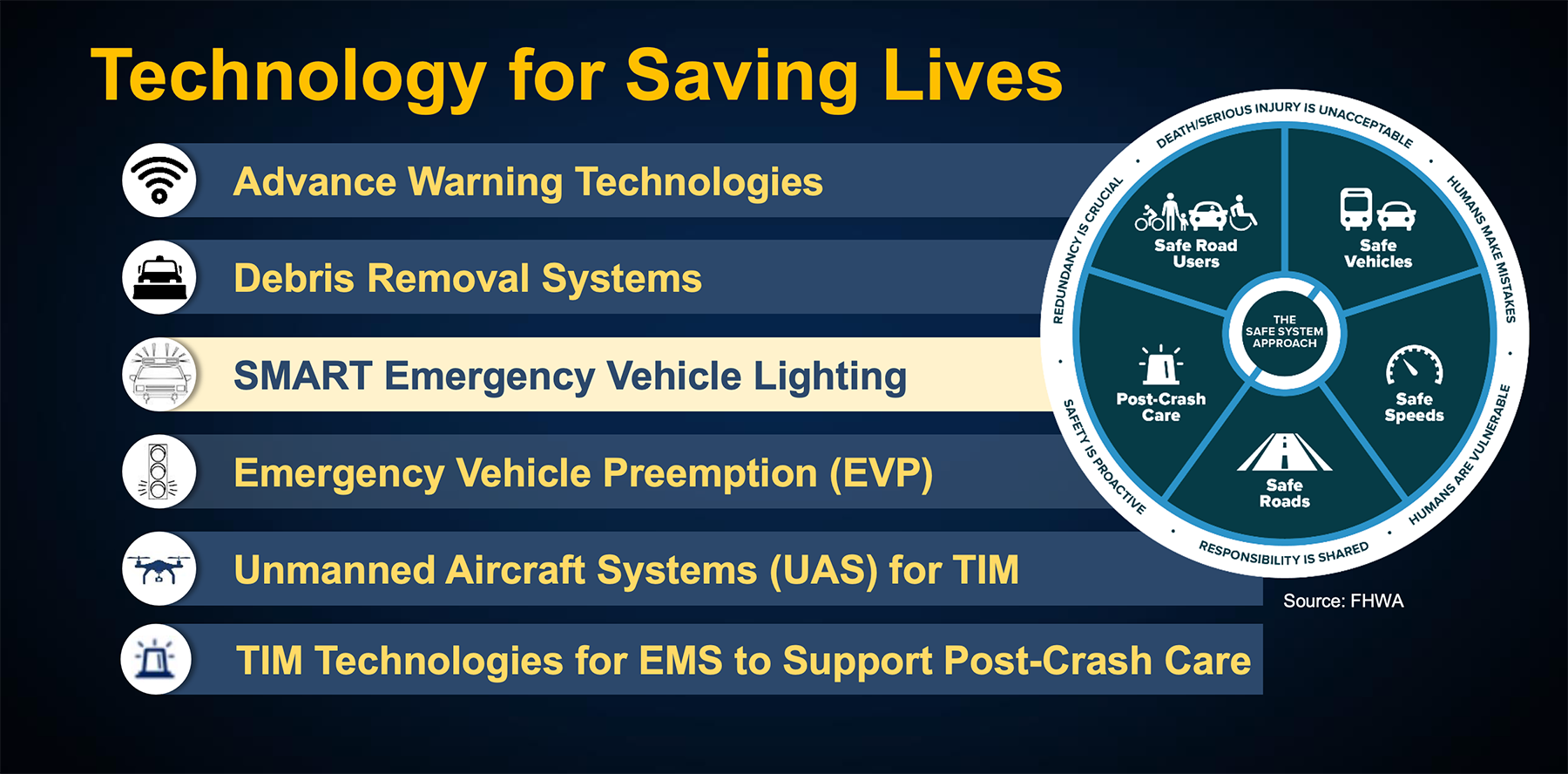
Brighter is Not Better: Emergency Vehicle Lighting Gets “Smart”
The attention-grabbing flashing lights at a traffic incident scene ahead are every driver’s cue to slow down, move over, and be cautious. However, achieving better driver visibility for responders does not always mean adding more or brighter lights to their vehicles. In fact, the Manual on Uniform Traffic Control Devices (MUTCD) warns that “the use of too many lights at an incident scene can be distracting and can create confusion for approaching road users, especially at night.”
Increasingly, traffic incident responders are looking for ways to communicate with approaching drivers while not blinding or distracting them. As part of Every Day Counts round 7 (EDC-7), the Next-Generation Traffic Incident Management (TIM) team is promoting a “SMART” approach to emergency vehicle lighting that can better inform roadway users, improve their ability to see roadside responders, and help them navigate around responders safely.

Example of synchronized emergency vehicle lighting.
Credit: Colorado Department of TransportationSMART, which stands for Strategic placement, Meaningful messaging, Automatic features, Reduced pattern intensity, and Tiered approach, leverages emergency lighting technology that is increasingly sophisticated and customizable with the use of LED lights and computer software.
Strategic placement
Many State laws dictate acceptable colors for the lights used by different responder disciplines, and the physical placement of the lights on responder vehicles is generally constrained by the shape of the vehicle body, automotive glass, and vehicle lamps. Near the traffic incident scene, flashing lights at the approximate height of a driver’s head are most conspicuous, but if a roadside responder is visible from farther away, that means approaching drivers have more time to slow down and move over. Roof-mounted emergency lights and vehicle-mounted changeable message signs can enhance advance warning, giving drivers added distance from the scene to reduce speed and to change lanes.
Meaningful messaging
Motorists perceive red, blue, and amber in a descending order of most to least hazard present. Aside from communicating hazard, systems with a directional sequencing of lights give drivers additional visual information. For example, a sequencing of a responder vehicle’s emergency lights from right to left can be recognized as a direction from emergency responders to drivers to move left, away from the shoulder.
Synchronization with other response vehicles is another important way that multiple response vehicles can work together to effectively convey a message to motorists. More than one responder vehicle displaying the sequencing lights from right to left is an even more powerful message to move left.
Automatic features
Emergency vehicle lighting systems are increasingly tied to the vehicle systems in which they are installed. Braking, doors opening, gear selection, and other vehicle functions can be linked to emergency lighting systems to elicit a specific response. For example, many fire apparatus now reduce forward facing lights when the parking brake is set, effectively reducing distraction for drivers in the opposite direction of travel.
Day and night light intensity is another way that responder vehicle lights can be adjusted automatically. Lights that are necessarily bright enough to see by drivers on a sunny day can become blinding to drivers at night.
Listen to a 30-minute presentation on “Good Practices and Current Research in Vehicle Lighting for Roadway Incidents.”
Credit: National Operations Center of ExcellenceReduced pattern and intensity
“Visual chaos” results when there are too many lights, too many different flash patterns, and light intensity is uncomfortable. For this reason, the National TIM Responder Training Program encourages responders to reduce lighting when multiple responder vehicles are present at a traffic incident scene. A “calm” scene is considered a safer scene where emergency lights are concerned. There is no one-size-fits-all solution for emergency lights, but technology is increasingly helping with user-selectable lighting displays that match the needs of the situation.

Emergency vehicle lighting is one of several technologies being promoted during EDC-7 NextGen TIM that agencies can implement to save lives.
Credit: FHWATiered approach
Rushing to the scene of an emergency requires lights and siren to get attention and clear the path. Once on the scene, a calmer flash rate and fewer emergency lights can be used. The calmer scene with less modulation among lamps is viewed as a safer scene. Once temporary traffic control is in place, even fewer lights may be needed. Agency policy that addresses the use of reduced lighting is beneficial, and lighting technology is increasingly complementary to policy in helping change the use of lights in a variety of settings. Stepping lighting usage down from response mode, initial arrival activities, and at a stable scene are examples of how a tiered approach might look.
“Emergency vehicle lighting is an important technology for roadway safety,” said NextGen TIM team co-lead Paul Jodoin. “Fortunately, advances in technology may help responders make better use of lights to communicate with drivers and ultimately protect both responders and motorists after traffic incidents.”
—MORE INFORMATION
Watch the February 2024 Talking TIM webinar to hear strategies for effective emergency vehicle lighting.
Visit the EDC-7 Next-Generation TIM webpage for links to more resources.
Contact Joe Tebo, James Austrich, or Paul Jodoin, FHWA Office of Operations, for details and technical assistance.
Disclaimer: The U.S. Government does not endorse products or manufacturers. Trademarks or manufacturers’ names appear in this document only because they are considered essential to the objective of the document. They are included for informational purposes only and are not intended to reflect a preference, approval, or endorsement of any one product or entity.
Except for the statutes and regulations cited, the contents of this document do not have the force and effect of law and are not meant to bind the States or the public in any way. This document is intended only to provide information regarding existing requirements under the law or agency policies.
Recommended Citation: U.S. Department of Transportation, Federal Highway Administration - Washington, DC (2024) Innovator Newsletter, May/June 2024, Volume 17 (102). https://doi.org/10.21949/1521779
- Cover
- New Opportunities for Building Bridges Better: The Evolution of UHPC
- Reconnecting Communities and Neighborhoods
- Brighter is Not Better: Emergency Vehicle Lighting Gets “Smart”
- Unlocking UAS Data: Strategies for Effective Management and Collaboration
- States Innovate
- EDC Outtakes: Next-Generation TIM
- About Innovator



